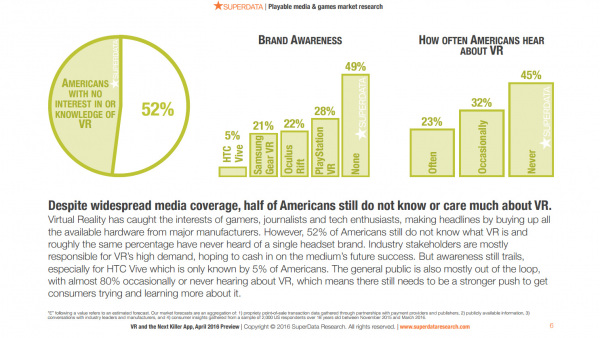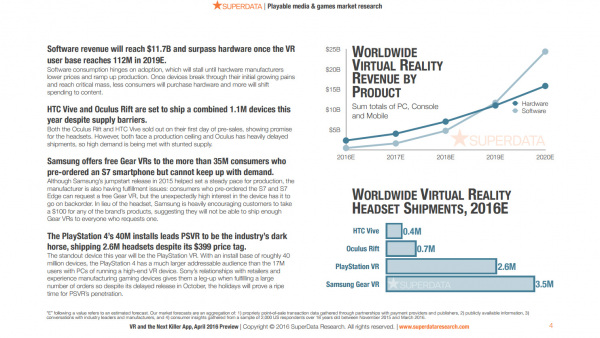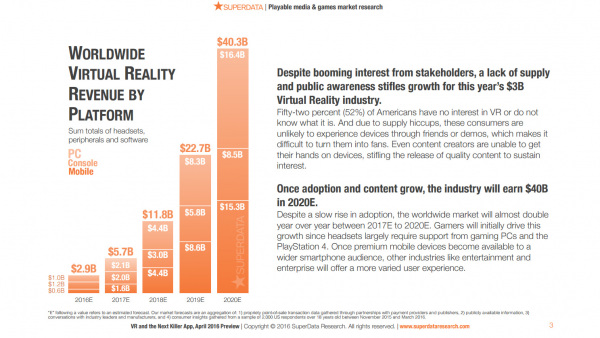Virtual Reality And It's Future, According To SuperData Research

To distract myself from refreshing my Oculus shipping information now might be a good time to check in on the state of the upcoming Virtual Reality market. Luckily, the wizards at SuperData Research have compiled a new report titled Virtual Reality & the Next Killer App. Lacking $1500 for the full PDF I figured it’s still worth discussing some of the key points included in the generous preview copy, complete with stylish graphics.
Being arrogant in my isolated world of tech I thought everyone knew Virtual Reality arrived this past month. Turns out nearly 80% of consumers have no idea what VR is, nor have they heard about it. The statistic shouldn’t be surprising. I doubt more than two people in my extended Irish family have heard of a GPU, let alone VR.
“The general public are mostly unaware of Virtual Reality with 50% of Americans showing no interest in or knowledge of VR,” says Stephanie Llamas, director of research and head of VR/AR strategy at SuperData. “Broad consumer adoption relies on building awareness, but today nearly 80% of consumers only occasionally or never hear about VR.”
I expect an eventual large-scale advertising push by both Facebook and HTC in the coming months, or at least once the 2016 holiday season kicks off (anyone want to place bets on an August start this year?) after first generation kinks are worked out. I find it reasonable that advertisers will focus on marketing more affordable mobile VR headsets as a way to introduce Grandma and other skeptical out-of-the-loop consumers, such as the Gear VR.
Perhaps the most interesting statistic revealed in SuperData’s report is that Sony will ship 2.6 million devices for the Playstation 4, even at a pricey $399. This figure does make sense. As there are many more consumers with a PS4 than a VR compatible PC. It’s likely that PSVR will be the shining star of the holiday 2016 season, and I suspect many gamers will experience VR for the first time through a PS4.
SuperData expects the VR industry to earn $40 billion in 2020, compared to a projected $2.9 billion in 2016—an almost vertiginous growth. They expect adoption to double in the next four years, spearheaded by gamers before other industries capitalize on VR’s potential. But the $2.9 billion is a revised forecast, down from $3.6 billion (March's estimate), and an initial $5.1 billion when SuperData first began forecasting. The launch of VR has been plagued by a number of issues, including delayed shipping, that have lead the team to revise their prediction.
It [the report] outlines that more than 13M Americans say they intend to purchase a VR headset this year, but only 7.2M are estimated to ship.
If you purchased an HTC Vive or Oculus perhaps you’re also waiting for a shipping confirmation order. Despite supply issues, the companies are expected to sell a combined 1.1 million devices. Production can’t keep up. And I wonder if the company’s internal projections failed to predict just how many tech enthusiasts are eager to try VR. Shipping issues prove that demand is real, and if you were a day one Oculus pre-order you remember how difficult it was to type in your credit card number.
Software for VR won’t trump hardware until 2019, but it will generate $11.7 billion. The statistic is intuitive: can’t expect to rake in software zeny until more consumers have a headset. Software doesn’t mean games either. And while games will drive the initial adoption of VR, software from other spheres will cement VR’s longevity. I would be surprised if Google isn’t already planning some future Google Maps that will utilize VR. An interesting figure states that by 2020 games will account for only 28% of overall spending on VR.
Delayed shipments have stifled the initial allure of VR, as only early adopters have their hands on a headset. Countless content creators, people who promote the product on their own channels such as MMOs.com, have been unable to obtain a headset, creating a lull in media buzz as smaller outlets wait patiently. I expect that by the end of the summer most consumers who were part of the initial rush will own VR, and a steady stream of VR content will circulate the web, generating hype among non-VR holders.
And the more people reviewing VR products the faster the industry can determine what does and doesn’t work. In it’s infancy developers are pushing software that is experimental at best. Plenty of gimmick will release to capitalize on a content starved audience seeking the next big experience. Until more consumers own VR, and more content creators and critics can evaluate software, VR will glide through a phase of questionable products. I wish I could whip up some novel idea to sell in this initial craze.
I do believe there will have to be a revolutionary VR application or concept still undiscovered, something that generates the interests of both tech enthusiasts and layman. What that is exactly I’m not sure but I imagine it will exist outside of gaming. Or, perhaps it won't be a singular killer app but a collection of new opportunities that sparks consumer interest, such as front row seats at the New York Philharmonic from the comfort of your living room.
While these initial years will likely be met with development lulls and hardware issues, SuperData predicts a flourishing future for Virtual Reality. And I plan to be part of it, if only my order information read "shipped."





